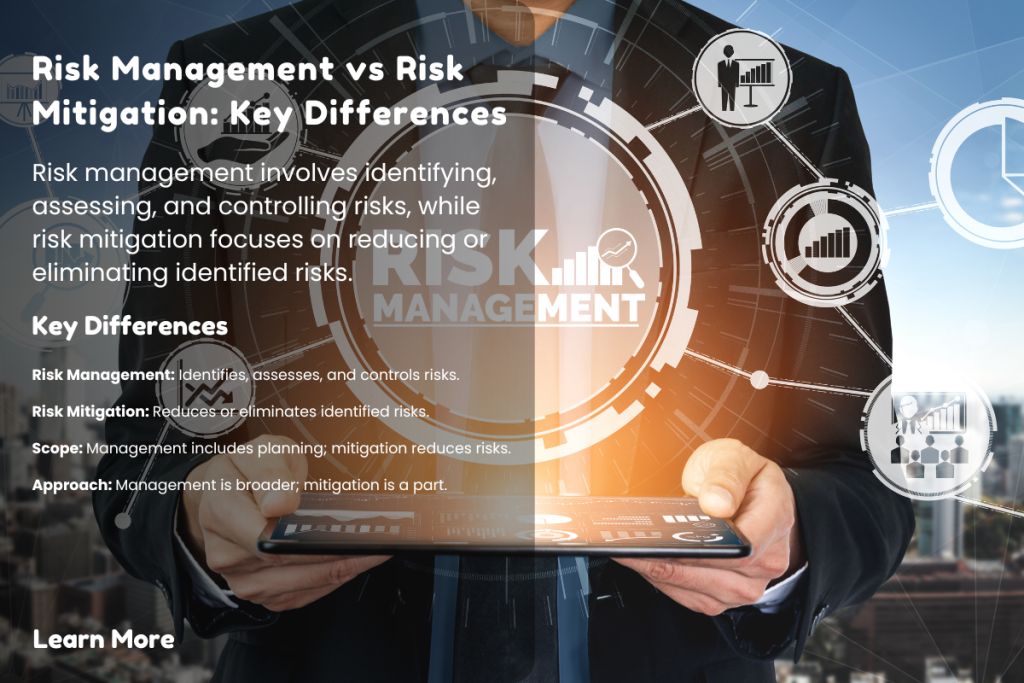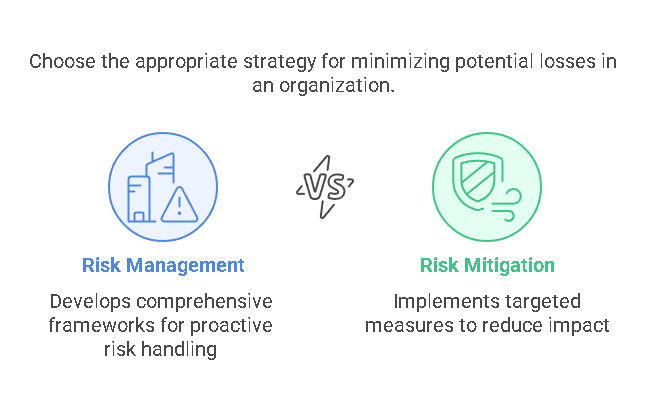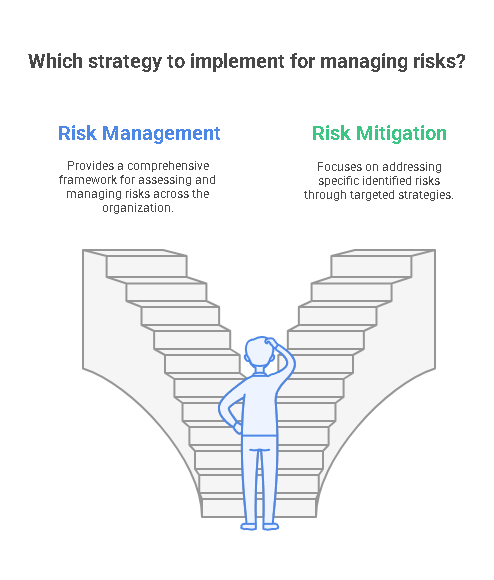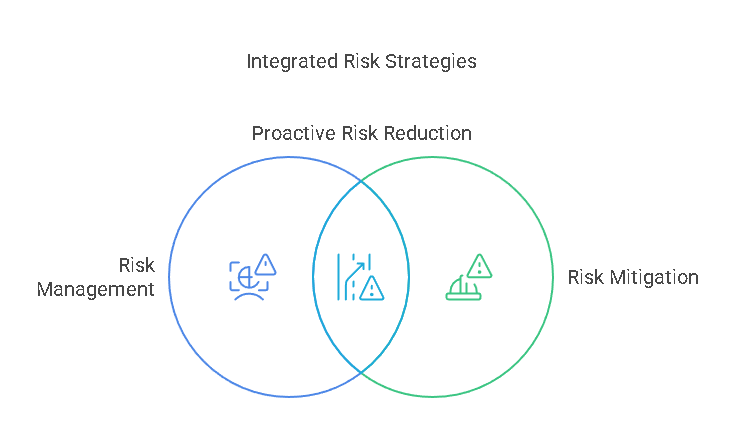Understanding Risk Management vs Risk Mitigation: What You Need to Know

Introduction to Risk Management and Risk Mitigation
Risk management and risk mitigation are two fundamental strategies used by organizations to protect themselves from potential threats. While the terms are often used interchangeably, they represent different approaches to managing and reducing risks in a business context.
Risk Management is a comprehensive process designed to identify, assess, and prioritize risks to minimize, monitor, and control the probability or impact of unfortunate events. It is a broad and strategic approach that focuses on preparing organizations for potential risks, allowing them to manage them proactively over time.
On the other hand, Risk Mitigation is a more focused strategy that comes into play once risks are identified. It involves specific actions designed to reduce or eliminate the impact of these risks. The goal of risk mitigation is to implement measures that will lessen the severity of any negative consequences from the identified risks.
Both strategies are essential components of an organization’s overall risk management framework, but their roles, goals, and applications differ. This article will delve deeper into the key differences, when to use each approach, and how they contribute to business continuity and safety.
The Key Differences Between Risk Management and Risk Mitigation

While both risk management and risk mitigation aim to minimize potential losses, they differ in scope, application, and execution.
- Scope:
- Risk Management is an overarching process that covers the entire risk landscape of an organization. It includes the identification, assessment, and prioritization of risks and seeks to develop an ongoing strategy for dealing with risks. Risk management is proactive, focusing on setting up frameworks and guidelines to address risks as they arise.
- Risk Mitigation, in contrast, is narrower in scope. It focuses specifically on reducing the impact of risks that have already been identified. It involves implementing targeted measures to minimize potential damage when a risk is realized.
- Focus:
- Risk Management focuses on the overall identification and assessment of potential risks that could impact an organization. It aims to create a long-term plan for identifying future risks and addressing them before they occur.
- Risk Mitigation is more tactical, focusing on reducing the negative consequences of identified risks. For example, if a business identifies a risk of cyber attacks, risk mitigation would involve implementing specific measures such as installing firewalls or using encryption technologies to prevent damage.
- Process:
- Risk Management typically follows a structured process, starting with risk identification, followed by risk assessment, evaluation, and control. It includes the development of risk treatment plans that outline how risks will be handled.
- Risk Mitigation follows once risks have been identified and assessed. It entails implementing specific strategies, like risk avoidance or risk reduction, to reduce or eliminate the severity of the identified risks.
When to Use Risk Management vs Risk Mitigation

Both Risk Management and Risk Mitigation play vital roles, but they are used in different contexts depending on the needs of the organization.
- Risk Management:
- Enterprise-wide risk management is often implemented in large organizations. It provides a framework for assessing all potential risks across various departments and business units, ensuring that risks are understood and proactively managed.
- Project management often involves risk management in the planning phase to anticipate potential problems that may arise during the project lifecycle. This could include risks related to timelines, budgets, or resources.
- Risk Mitigation:
- Specific risks that have been identified through risk management processes often trigger the need for risk mitigation. For example, a business might identify a financial risk related to supply chain disruptions, and risk mitigation might involve diversifying suppliers or obtaining insurance.
- Operational risks are common scenarios where risk mitigation is applied. For example, a healthcare facility may implement mitigation strategies to prevent medical errors, such as by using technology to reduce human error or enhancing staff training programs.
Components of Risk Management
Risk management consists of several essential components that work together to form a cohesive framework for identifying, assessing, and responding to risks. These components include:
- Risk Identification: The first step in the risk management process involves identifying potential risks that may affect an organization. This could include anything from financial losses, supply chain interruptions, reputational damage, or even cybersecurity breaches.
- Risk Assessment: After identifying risks, organizations must assess their likelihood and potential impact. This involves estimating how likely each risk is to occur and determining how severe the consequences would be.
- Risk Evaluation: In this phase, businesses evaluate the potential risks based on their likelihood and impact, prioritizing them accordingly. Risks that have a high likelihood of occurrence and significant potential impact are typically prioritized for immediate action.
- Risk Treatment: Once risks are identified, assessed, and evaluated, risk treatment involves determining the best course of action to handle them. This could include mitigating the risk, transferring it (e.g., through insurance), or accepting the risk if its impact is minimal.
- Risk Monitoring and Review: Risk management is an ongoing process, and organizations must continuously monitor and review their risk strategies to ensure they are effective. This helps to identify any new risks or changes to existing risks that may require a revised approach.
Risk Mitigation Techniques
Risk mitigation encompasses various strategies and actions that help organizations reduce or eliminate the impact of identified risks. These techniques are specific to the nature of the risk and can vary widely depending on the industry or sector. Some common risk mitigation techniques include:
- Risk Avoidance: Risk avoidance involves eliminating the risk altogether by changing plans, strategies, or processes. This is often the most effective way to mitigate a risk, but it may not always be feasible.
- Risk Reduction: Risk reduction focuses on minimizing the likelihood or impact of a risk. This may involve adopting new technologies, enhancing staff training, or implementing more rigorous safety protocols.
- Risk Sharing: This involves transferring the risk to another party, typically through outsourcing or purchasing insurance. For example, a company may purchase cyber insurance to transfer the financial risk associated with a data breach.
- Risk Retention: In some cases, organizations may decide to accept certain risks if they are unlikely to have a significant impact or if the cost of mitigating them outweighs the benefits. This is often done when the risk is low and manageable.
Key Benefits of Risk Management and Risk Mitigation
Both risk management and risk mitigation offer numerous benefits that contribute to the long-term success of an organization.
- Minimizing Losses: Properly identifying and managing risks can help minimize potential losses, whether they are financial, operational, or reputational.
- Business Continuity: A strong risk management strategy ensures that a business is prepared for unexpected events, enhancing its ability to remain operational in the face of adversity.
- Enhanced Decision-Making: Having a clear understanding of the risks an organization faces allows leadership to make better, more informed decisions.
- Regulatory Compliance: Effective risk management and mitigation strategies help organizations remain compliant with legal and regulatory requirements, thus reducing the risk of legal repercussions.
Step-by-Step Process for Implementing Risk Management
The process of implementing effective risk management within an organization is structured and multifaceted. Organizations need to take a methodical approach to identify, assess, and address risks to protect their assets, reputation, and operations. Below is a comprehensive guide to help you navigate the steps involved in a risk management strategy:
1. Identifying Potential Risks
The first step in the risk management process is risk identification. This involves looking at both internal and external factors that could pose a risk to an organization’s operations. Risks could be financial, operational, legal, reputational, technological, or environmental in nature.
- Internal Risks: These are risks that stem from within the organization itself, such as financial mismanagement, operational inefficiencies, or employee misconduct.
- External Risks: These are risks outside the organization’s control, such as changes in government regulations, natural disasters, or economic recessions.
Tools like brainstorming sessions, interviews with key stakeholders, industry reports, and risk assessment workshops can help identify potential risks.
2. Assessing Risk Likelihood and Impact
Once risks have been identified, it’s crucial to assess the likelihood of each risk happening and the potential impact it would have on the organization. This stage involves quantifying or categorizing risks in terms of probability and severity.
- Likelihood: How probable is it that this risk will occur? This can be assessed through data analytics, historical trends, or expert judgment.
- Impact: If the risk does occur, what would be the potential damage? Organizations should evaluate financial losses, reputational damage, operational disruptions, and legal consequences.
A common approach to this is the Risk Matrix, which classifies risks based on their likelihood and impact, assigning a priority level to each risk.
3. Developing Response Strategies
After assessing the risks, organizations must develop response strategies. These strategies outline how each identified risk will be managed.
- Avoidance: For high-impact and high-likelihood risks, an organization might choose to avoid them altogether by altering plans, processes, or operations.
- Mitigation: For risks that are unavoidable, mitigation measures are designed to reduce the severity or impact of the risk. This might include implementing safety protocols, adopting new technologies, or developing contingency plans.
- Transference: Risk transference involves shifting the risk to a third party, often through purchasing insurance or outsourcing certain activities.
- Acceptance: In some cases, organizations may decide to accept a certain level of risk, particularly when the cost of mitigating the risk is higher than the potential impact.
4. Monitoring and Reviewing Risk Management Efforts
Effective risk management is an ongoing process. Organizations must continuously monitor the risks and regularly review their risk management strategies to ensure they remain effective.
- Continuous Monitoring: This involves actively tracking the identified risks to ensure they are being managed appropriately. This can be achieved through regular audits, reporting mechanisms, and key performance indicators (KPIs).
- Review and Adjustment: The risk landscape is always evolving. As new risks emerge or current risks evolve, organizations should reassess their strategies and adjust them accordingly.
Organizations should also engage in post-event analysis to evaluate the effectiveness of their risk management strategies after a risk event has occurred.
Risk Mitigation Strategies in Practice
Risk mitigation is the process of implementing specific measures to reduce or eliminate the impact of risks. Unlike risk management, which is a broader strategy, risk mitigation is more tactical and addresses specific risks identified through the management process. Below are some common risk mitigation strategies:
1. Preventive Measures
Preventive measures aim to eliminate or reduce the likelihood of a risk occurring in the first place. By proactively identifying potential threats, organizations can take steps to avoid them altogether.
- Example: In cybersecurity, companies can implement firewalls, encryption protocols, and regular software updates to prevent data breaches. Similarly, a manufacturing plant can implement machinery maintenance schedules to prevent mechanical failures.
Preventive actions help minimize the exposure to risks and create a more secure operating environment.
2. Contingency Planning
Contingency planning involves preparing a response for when risks inevitably occur. This ensures that businesses can continue to operate smoothly in the face of disruption.
- Example: In the event of a natural disaster, an organization might have a contingency plan that includes backup facilities, an emergency communication system, and predefined roles for employees to follow during a crisis.
Contingency plans help organizations maintain business continuity, even when risks materialize.
3. Insurance
Insurance is a widely used method of risk mitigation, particularly in industries where risks are significant and could have financial repercussions. By transferring the risk to an insurance provider, companies can mitigate the financial impact of adverse events.
- Example: Companies in the construction industry may carry liability insurance to protect against potential lawsuits arising from accidents or property damage. Similarly, businesses in the healthcare sector may have malpractice insurance to cover the costs associated with medical negligence.
Insurance doesn’t eliminate the risk but ensures financial protection when risks result in significant losses.
4. Diversification
Diversifying operations, products, or investments is a classic risk mitigation strategy. By spreading risk across multiple areas, organizations reduce their exposure to any single risk.
- Example: A company may mitigate financial risks by diversifying its investments into different markets or industries. In the case of a food retailer, diversifying product offerings (e.g., offering both perishable and non-perishable goods) can help minimize supply chain risks.
Diversification is particularly useful in industries where risks are highly unpredictable and can be minimized by spreading exposure.
5. Compliance and Regulatory Measures
Risk mitigation often involves adhering to regulations and ensuring compliance with industry standards. Organizations must stay up to date with evolving regulations, whether they are financial, environmental, safety, or privacy-related.
- Example: In healthcare, organizations are required to comply with HIPAA (Health Insurance Portability and Accountability Act) to mitigate the risk of data breaches and privacy violations. Non-compliance can lead to significant legal and financial penalties.
Compliance-based risk mitigation ensures that businesses avoid legal repercussions and maintain their operations within the boundaries of the law.
How Risk Management and Risk Mitigation Work Together

While risk management and risk mitigation are distinct strategies, they often work together as part of a broader risk strategy. By combining both approaches, organizations can create a more resilient and comprehensive risk management framework.
- Integration of Strategies: Risk management lays the foundation for identifying and assessing risks, while risk mitigation provides the tools and actions necessary to address the risks identified in the management phase. For example, once a risk is identified and assessed in the risk management process, the organization can implement mitigation measures to reduce its impact.
- Case Study – Construction Industry: In the construction industry, risk management involves identifying potential risks such as safety hazards, project delays, and regulatory compliance issues. Once these risks are identified, risk mitigation strategies—such as safety training, scheduling buffers, and regulatory audits—are implemented to reduce their impact on project timelines and costs.
By integrating both strategies, organizations ensure that they are not only prepared for potential risks but are also taking proactive steps to reduce their negative consequences.
Precisehire: Risk Management Through Employment Screening
For organizations looking to manage risks through their workforce, Precisehire is a valuable service provider that specializes in background checks and employment screening. Managing risk effectively requires ensuring the integrity of an organization’s workforce, and Precisehire plays a crucial role in identifying potential risks associated with employees, contractors, or new hires.
Precisehire provides comprehensive criminal background checks, helping businesses mitigate the risk of hiring individuals with hidden criminal histories or other concerns that could impact the safety, performance, and reputation of the organization. The platform is designed to ensure compliance with legal regulations and industry standards, allowing organizations to maintain a compliant and secure workforce.
- Employment Screening: Precisehire offers services for screening potential hires, contractors, and volunteers, ensuring that employers have the right information to make informed hiring decisions.
- Criminal Background Checks: By conducting thorough background checks, Precisehire helps organizations reduce the risk of hiring employees with criminal histories that could pose a threat to workplace safety or company culture.
- Compliance Management: Precisehire supports businesses in staying compliant with regulations related to hiring and employee screening, reducing the risk of legal repercussions and ensuring that hiring practices are in line with industry best practices.
| Risk Mitigation Strategy | Key Benefit | Example |
|---|---|---|
| Preventive Measures | Reduces the likelihood of risks occurring. | Implementing safety protocols in a manufacturing plant to prevent accidents. |
| Contingency Planning | Ensures business continuity during unforeseen events. | A financial institution develops a disaster recovery plan for IT system failures. |
| Insurance | Provides financial protection from the consequences of risks. | Purchasing property insurance to protect against fire damage. |
| Diversification | Reduces exposure to single-point failures or risks. | A business diversifies its investment portfolio to hedge against market downturns. |
| Compliance and Regulatory Measures | Ensures alignment with laws and reduces legal risks. | A healthcare provider complies with HIPAA regulations to mitigate the risk of data breaches. |
| Transference | Shifts risk to a third party to reduce direct exposure. | Outsourcing manufacturing operations to a third-party vendor to avoid production-related risks. |
| Acceptance | Acknowledges a risk and prepares for its potential impact. | A small business accepts the risk of slow customer payment in exchange for offering credit to clients. |
Legal Considerations in Risk Management and Mitigation
Understanding the legal frameworks that govern risk management and risk mitigation is critical for businesses, as failing to comply with regulations can lead to severe penalties, reputational damage, or legal liability. Below, we explore some of the major legal aspects of risk management and mitigation:
1. Regulatory Compliance
Businesses are required to adhere to various regulatory standards to mitigate legal risks and ensure operational continuity. Legal frameworks for compliance often dictate how businesses must identify, assess, and manage risks. These regulations can come from local, state, or international authorities.
For instance, businesses in industries such as finance, healthcare, and data management are bound by specific regulations:
- GDPR (General Data Protection Regulation): Imposes strict rules on data protection and privacy for individuals in the European Union. Non-compliance can result in hefty fines.
- OSHA (Occupational Safety and Health Administration): In the U.S., OSHA standards require businesses to manage risks associated with workplace safety, including the use of personal protective equipment (PPE) and maintaining safe work environments.
- HIPAA (Health Insurance Portability and Accountability Act): Healthcare organizations must mitigate risks associated with patient data security to ensure privacy and avoid legal repercussions.
These frameworks influence the way risk management strategies are developed and enforced. Ensuring compliance with these regulations is a critical aspect of managing legal risks effectively.
2. Risk Management in Contracts
Legal contracts often contain clauses to help manage and allocate risks between parties. These clauses outline how various risks (e.g., breaches, delays, or failure to meet service levels) are handled and what each party’s responsibilities are if the risk materializes.
For example, force majeure clauses in contracts may outline actions to be taken in the event of unforeseen circumstances like natural disasters, wars, or other events that may delay or prevent performance. Businesses should ensure that risk management strategies are integrated into their contracts to minimize exposure and provide clear guidance on how risks will be managed and mitigated if they arise.
3. Legal Implications of Poor Risk Management
Failure to manage risks effectively can expose businesses to significant legal consequences. For example, inadequate risk management in relation to employee safety can lead to workplace injuries, lawsuits, and regulatory fines. Similarly, not managing data breaches can lead to violations of privacy laws, resulting in hefty penalties.
In terms of employment law, poor risk management practices can lead to discrimination lawsuits if hiring practices are not handled in compliance with the Equal Employment Opportunity Commission (EEOC) guidelines, which protect candidates from discrimination based on race, gender, or other factors.
Therefore, businesses must integrate risk mitigation strategies that comply with relevant laws to avoid legal disputes and maintain operational stability.
FAQs: Commonly Asked Questions About Risk Management and Risk Mitigation
What Are the Main Differences Between Risk Management and Risk Mitigation?
Risk management is a broad, strategic framework that involves identifying, assessing, and responding to risks within an organization. It encompasses various processes, including risk identification, assessment, and control, which help organizations prepare for a range of potential threats.
On the other hand, risk mitigation refers to specific strategies or actions that reduce the impact or likelihood of a particular risk. Mitigation techniques are tactical measures that are part of the broader risk management plan.
When Should a Business Prioritize Risk Mitigation Over Risk Management?
Risk mitigation should be prioritized when a specific risk is identified as highly likely to occur and has the potential to cause significant damage. For example, businesses in sectors like construction, finance, or IT security may prioritize mitigation strategies for highly impactful risks such as workplace accidents, financial fraud, or cyber-attacks.
Risk management, on the other hand, is an ongoing, proactive approach that should always be in place to identify and address risks before they escalate.
How Do Organizations Assess Risk Impact and Likelihood?
Organizations typically assess risk by considering the likelihood of an event occurring and its potential impact on operations. A risk assessment matrix can be used, categorizing risks into different levels (low, medium, high) based on how likely they are to occur and how severe the consequences would be.
Risk analysis tools, such as qualitative and quantitative methods, help organizations estimate the potential cost or damage from risks. By considering both the likelihood and impact, businesses can prioritize their risk mitigation efforts accordingly.
What Are the Legal Implications of Poor Risk Management in Business?
Poor risk management can lead to legal implications like regulatory fines, lawsuits, and reputational damage. Businesses that fail to manage financial, operational, or compliance risks can face severe penalties for violations. For instance, poor handling of workplace safety risks may lead to OSHA violations, while mishandling data privacy can result in violations of GDPR or HIPAA laws.
By failing to incorporate risk management into day-to-day operations, businesses expose themselves to both financial and legal risks that could compromise their long-term stability.
Can Risk Mitigation Be Outsourced, and If So, How?
Yes, risk mitigation can be outsourced, especially when specific expertise is required. For example, a company can hire an insurance provider to transfer certain financial risks or engage a third-party cybersecurity firm to mitigate the risk of data breaches.
Outsourcing can be particularly beneficial in areas where the organization lacks the expertise or resources to address risks effectively. However, businesses should thoroughly vet external service providers and ensure that the outsourcing arrangement aligns with their risk management strategy and goals.
Conclusion
In summary, risk management and risk mitigation are both essential components of a comprehensive risk strategy for businesses. While risk management provides a framework for identifying and assessing potential risks, risk mitigation focuses on specific actions to reduce the impact of those risks. By integrating both approaches, organizations can ensure that they are prepared for potential challenges and able to respond effectively.
The legal considerations surrounding both strategies cannot be overlooked. From compliance with regulatory standards to ensuring fair treatment in employment practices, businesses must navigate the complex legal landscape to avoid costly fines and reputational damage.
Additionally, Precisehire can play a crucial role in helping organizations mitigate risks, particularly in employment-related matters. By offering criminal background checks and employment screening services, Precisehire helps businesses ensure that their workforce complies with legal and regulatory requirements, minimizing the risk of hiring individuals who may pose potential threats to the organization’s stability.
Ultimately, a balanced approach to risk management and risk mitigation is critical for the long-term success and legal compliance of any business.
